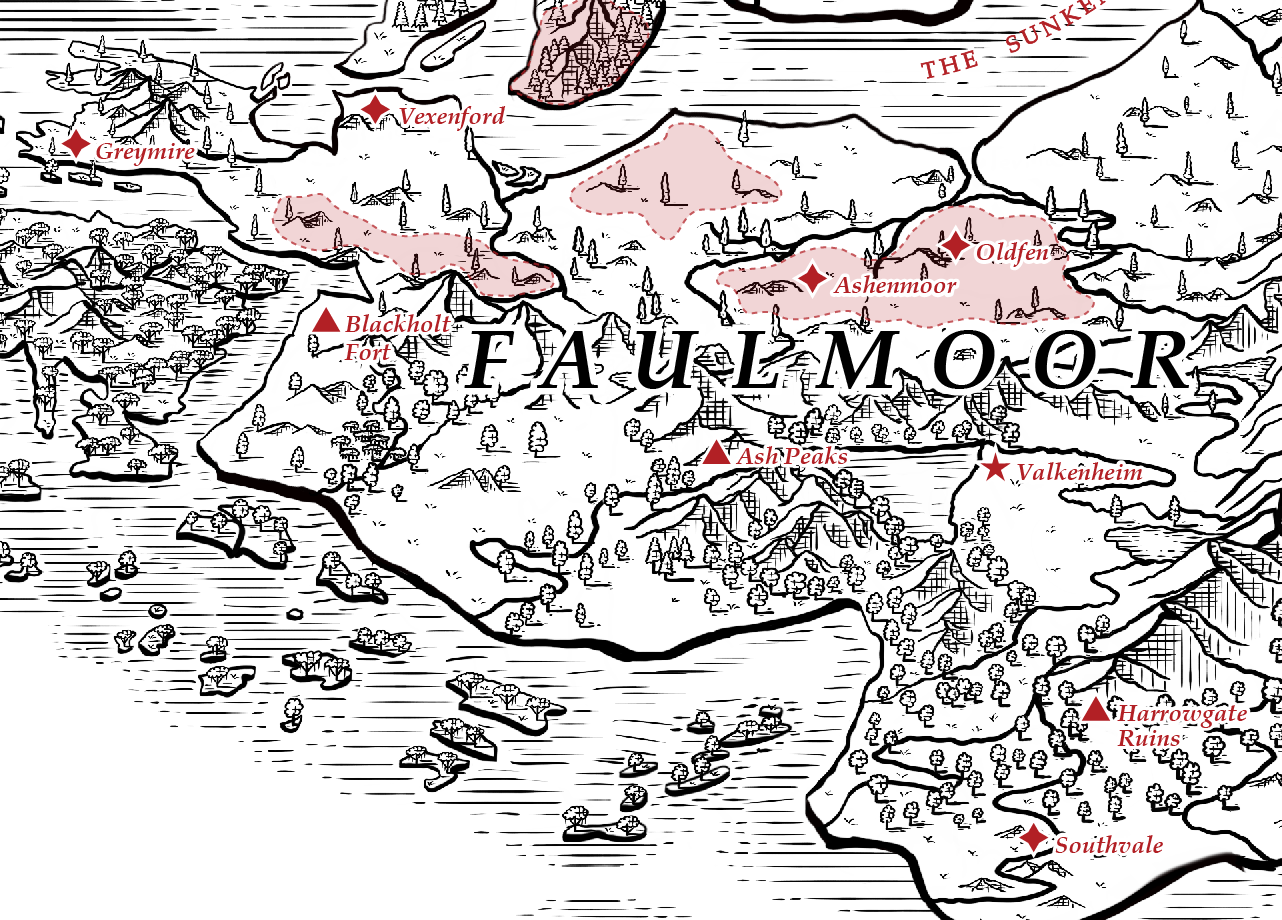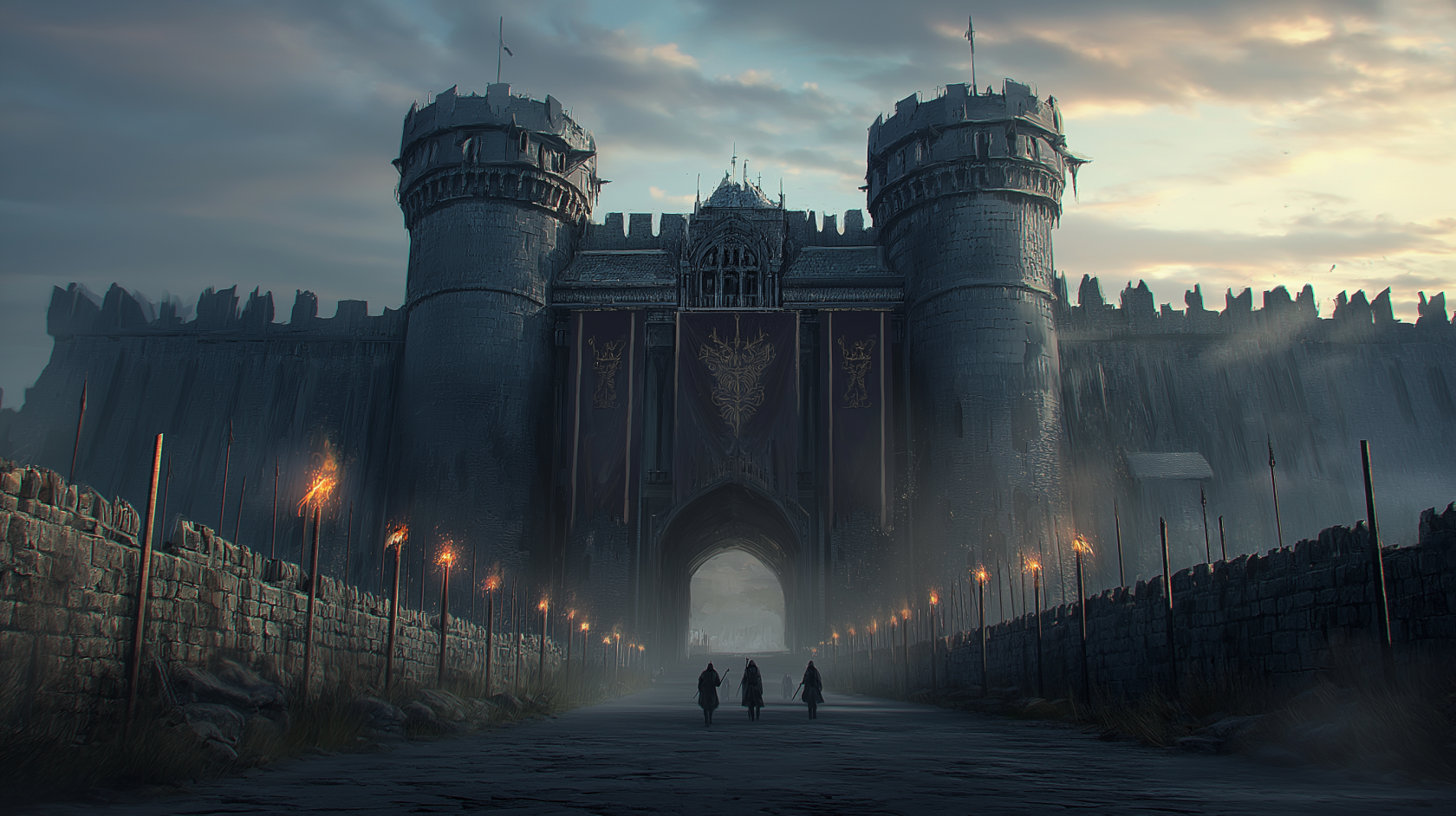Valkenheim
Steel and Sacrifice
Valkenheim is a golden lantern in the dark, its light a promise against the creeping night. It stands tall, unwavering, a symbol of warmth and safety for those who call it home. Yet, even the brightest lantern must be tended, its flame carefully shielded, lest the winds of despair snuff it out and leave us all to the shadows.
Valkenheim, the capital of Faulmoor, stands as a beacon of false hope amid the chaos of the Rotmire Blight. Unlike much of the kingdom, the city is blessed with a more temperate climate, where the sun regularly shines upon its stone streets and well-kept gardens. From a distance, it appears almost idyllic, a place of serenity untouched by the creeping decay that threatens the land. Yet, beneath its polished veneer lies a carefully maintained illusion, masking the deep-rooted fear and iron grip of House Valkenmar.
At the heart of Valkenheim is the Blackspire, an imposing fortress that dominates the skyline with its high walls and blackened towers.
It was once a symbol of strength and governance, but now it serves as the secluded bastion of Baron Malric Valkenmar, who has grown increasingly detached from his people. Overcome with grief from the loss of his family to the Blight, he has turned inward, obsessing over containment and a cure, isolating himself from all but his most trusted retainers. The fortress is heavily fortified, its exterior stark and unwelcoming, a stark contrast to the city’s bright and lively facade.
Despite the Baron’s descent into paranoia, his younger brother, Ivor Valkenmar, has taken on the role of a reluctant steward, working tirelessly to maintain order and alleviate the fears of the people. He ensures that life within the city walls remains as normal as possible, keeping markets open, overseeing festivities, and promoting a sense of community. Under his careful guidance, Valkenheim retains a sense of peace, and its people continue to go about their daily lives as if the horrors beyond their walls do not exist. The city’s well-maintained streets, bustling marketplaces, and flourishing gardens serve as a stark contrast to the brutal and heavily fortified defenses surrounding it.
Gaining entry into Valkenheim is near impossible for most. The towering gates are shut to outsiders, and the walls are patrolled day and night by the city’s hardened enforcers. Identification papers are required to pass through the gates, and even then, only those deemed essential—official envoys, select merchants, and high-ranking individuals—are granted access. Refugees, wanderers, and those fleeing the horrors of the Blight are turned away without question, left to fend for themselves beyond the fortified walls.
Yet, as with all things, there are always ways for the determined or the wealthy. Bribing the right officials or gaining favor with one of the influential figures in Valkenheim can open doors that would otherwise remain closed. Smugglers operating through the Duskwater Canal have been known to ferry in those willing to pay the exorbitant price, and secret tunnels—though perilous and ever-changing—whisper of hidden paths into the city. For those with enough coin or cunning, the impenetrable walls of Valkenheim are not as absolute as they seem.
Beyond the city’s walls, however, the reality of Faulmoor’s plight is inescapable. Towers loom over reinforced gates, ballistae and barricades stand ready, and any who dare approach uninvited are met with cold steel. Duskwater Canal, which once served as a vital trade route, now serves as a silent reminder of the city’s desperation—its dark waters carrying away the bodies of the infected, ensuring that the city’s pristine illusion is not disturbed by the truth of what lies beyond. Soldiers patrol the perimeter tirelessly, their presence a necessity to keep the horrors of the Blight at bay.
Valkenheim’s people live within this delicate balance of beauty and brutality. While the city itself provides comfort and safety, the knowledge of what lurks beyond its walls casts a long shadow. The Gilded Exchange thrives, offering silver, food, and medicine, but behind closed doors, smugglers and dissidents work to undermine the Baron’s control. The Silverclad Spire, once a cathedral of faith, now serves as a research center where alchemists and scholars secretly conduct their experiments in pursuit of a cure. The city’s peace is a carefully orchestrated performance, and while Ivor Valkenmar does his best to maintain the illusion, the cracks in the facade are beginning to show.
Detailed Overview
| Attribute | Details |
|---|---|
| Region | Faulmoor |
| Ruling House | House Valkenmar |
| Population (Before Blight) | 25,000 (Estimated) |
| Population (After Blight) | 10,000 (Estimated) (Under strict lockdown) |
| Major Industries | Governance, Military Command, Research |
| Primary Exports | Weapons, Armor, Relics (Restricted) |
| Current Ruler | Baron Valkenmar |
| Government Type | Feudal Rule under Baron Valkenmar |
| Defenses | Fortified walls, elite guard, magical wards |
| Notable Features | Seat of power, quarantined research |
| Status | Under military lockdown, extreme quarantine measures |
Notable Locations
The Blackspire
The seat of House Valkenmar and the city’s most imposing structure. Blackspire looms over Valkenheim, its towering black walls a stark reminder of the Baron’s iron rule. Within its cold halls, alchemists toil over forbidden experiments, while Malric Valkenmar broods over the future of his crumbling domain.
The Gilded Exchange
Once a thriving market, now a tightly controlled hub of commerce where silver, medicine, and food dictate survival. Merchants trade under the watchful eyes of House Valkenmar’s enforcers, and beneath the surface, smugglers barter with those willing to risk the Baron’s wrath.
The Silverclad Spire
A towering cathedral-turned-research facility. Once devoted to faith, it now serves as a place of desperate experimentation, where alchemists and scholars test dubious treatments for the Blight. The faithful still gather in its upper chambers, praying for salvation while dark dealings take place below.
Duskwater Canal
A winding waterway that snakes through the city, its dark waters carrying away the bodies of the infected. Once a symbol of trade and prosperity, it is now a grim reminder of the city's struggle against the Blight. It is said that those who fall into its depths do not always stay dead.
The Sunveil Gardens
A breathtaking display of greenery and flowers that flourish despite the turmoil. Maintained by Ivor Valkenmar as a place of respite, the gardens are a symbol of hope for the people, but also a carefully constructed illusion to distract from the city’s harsher realities.
The Ironveil Barracks
Home to Valkenheim’s elite enforcers, these barracks house the brutal warriors who maintain order. Clad in dark steel and trained to act without hesitation, they are both the city’s protectors and its oppressors.
The Widow’s Walk
A high balcony overlooking the Duskwater Canal, where executions are carried out. Those deemed enemies of House Valkenmar or carriers of the Blight are thrown from its heights into the dark waters below, their fate sealed by the city’s silent judgment.
Notable Establishments
The Golden Hearth
A lavish inn catering to nobles, merchants, and the city’s elite. Its fine cuisine, luxurious decor, and warm atmosphere make it a sought-after refuge from the troubles of Valkenheim—though only those with influence or wealth can afford its comforts.
The Black Flagon
A rowdy tavern known for its strong spirits and even stronger tempers. Frequented by mercenaries, traders, and those seeking work, it is a place where deals are struck, alliances formed, and brawls break out nightly.
The Hollow Quill
A quiet, dimly lit bookshop where scholars, scribes, and those with an interest in forbidden knowledge gather. Rumors persist that certain texts hidden within its shelves contain knowledge of the Blight’s origins and the means to fight it.
The Silver Vein
A gambling hall and den of illicit pleasures, where fortunes are won and lost in the blink of an eye. House Harrowden’s influence runs deep here, and those who cross the wrong people often disappear without a trace.


